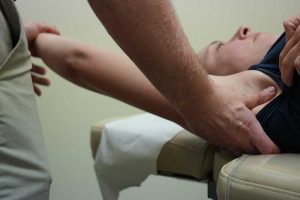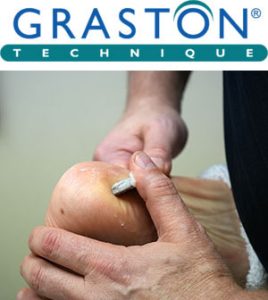Techniques

ACTIVE RELEASE TECHNIQUE
Tissue damage can be caused by:
- excessive postural overstrain (e.g. sitting long hours at a computer screen in an ergonomically incorrect posture)
- repetitive strain injuries (e.g. repetitive typing on a keyboard that does not allow for full range of motion of the metacarpo-phalangeal joints of the fingers)
- direct trauma (e.g. a running back being blindsided by a 300 pound linebacker)
 Active Release Technique (ART) is one of the most effective deep tissue techniques for breaking down scar tissue/adhesions and restoring function and movement. Active release technique involves the doctor locating adhesions that are causing the problem, applying tension with the thumbs over these lesions in the direction of the fibers, and then having the patient elongate the musculature while the doctor continues to apply tension to the lesion. By breaking up the adhesions and restoring proper blood flow to the tissues, the patient’s condition will steadily improve. Dr. Dubin was the first doctor credentialed in Active Release Technique in Massachusetts. Active release technique protocols, combined with adjustments, strength training, flexibility training, and other modalities such as combotherapy, enable Dr. Dubin to have predictable treatment success when dealing with musculoskeletal injuries involving the spine or the extremities.
Active Release Technique (ART) is one of the most effective deep tissue techniques for breaking down scar tissue/adhesions and restoring function and movement. Active release technique involves the doctor locating adhesions that are causing the problem, applying tension with the thumbs over these lesions in the direction of the fibers, and then having the patient elongate the musculature while the doctor continues to apply tension to the lesion. By breaking up the adhesions and restoring proper blood flow to the tissues, the patient’s condition will steadily improve. Dr. Dubin was the first doctor credentialed in Active Release Technique in Massachusetts. Active release technique protocols, combined with adjustments, strength training, flexibility training, and other modalities such as combotherapy, enable Dr. Dubin to have predictable treatment success when dealing with musculoskeletal injuries involving the spine or the extremities.
The Role of Active Release Technique in the Three Stages of Tissue Healing
The first 24-48 hours of the tissues’ initial healing response is termed the “reactive phase.” During this phase, prostaglandins are produced, causing pain and inflammation as well as activation of the body’s local and systemic healing processes. The PRICES method of self-treatment is crucial during the initial stage of the injury to limit the primitive response of inflammation and create a better environment for the body to heal itself. The second stage of healing is called the “reparative phase” and consists of three reactions. First, the body’s immune system attacks and breaks down the debris at the site of injury. Then, new blood vessels form in the tissues, supplying increased oxygen and nutrients. Finally, there is fibroblast proliferation, which involves the replacement of the injured tissue with new muscle fibers. However, these fibers are not aligned properly, and contracted scar tissue formation can be expected. During this phase, the patient frequently experiences pain in the trigger points, which are regions where the scar tissue/ adhesions exist. The contracted scar tissue has a decreased blood flow that not only limits oxygen and nutritional uptake, but also slows down removal of noxious chemicals. This is why these trigger points are tender to the touch. A contracted muscle is not nearly as strong as an elongated muscle; a contracted muscle will limit full rehabilitation potential. Also, a contracted muscle demands more energy than an elongated relaxed muscle, and rehabilitation is further impeded by decreased blood flow. The last phase is “tissue repair,” where the goal of treatment is to regain the pre-injury strength and flexibility of the damaged tissue. During phases 2 and 3, treatment focus should be on restoring proper alignment and function of the newly laid down and disorganized muscle fibers. This will create a more favorable environment for healing to occur and will potentially allow the patient to regain 100% function to this region. Deep tissue manipulation such as ART enables the doctor to achieve this goal.
 GRASTON TECHNIQUE
GRASTON TECHNIQUE
A soft tissue treatment technique using beveled steel instruments to break up adhesions/scar tissue and promote healing.
ADJUSTMENTS
Adjustments are high-velocity, low-force techniques, used by chiropractors to restore motion to the joints in the spine and extremities. Back pain can be caused by trauma and postrual overstrain. This can cause entrapment of the synovial folds in the facet joints of the spine, which can lead to pain, spasm, and swelling. Adjustments can free up the synovial folds, providing pain relief.
ULTRASOUND / ELECTRICAL MUSCLE STIMULATION COMBOTHERAPY
Muscles consist of a bunch of individual muscle fibers. Injury that results in pain can cause inhibition of these fibers. Electrical muscle stimulation is a biphasic wave form that sends sensory input into the sensory end organs of individual muscle fibers causing the inhibited fibers to contract. Thereby restoring normal muscle tone.
Low frequency ultrasound absorbs into soft tissues creating deep heat. Both ultrasound and electrical muscle stimulation are forms of biomecanical energy that aid in speeding up the healing process.
Effects of Ultrasound / Electrical Muscle Stimulation Combotherapy
1. Speeds up healing process
2. Decreasing pain
3. Restore normal muscle tone
STRENGTH AND FLEXIBILITY TRAINING
Dr. Dubin is a certified strength and conditioning specialist. He can customize a strength and flexibility program for individuals to conduct at home or in a gym. A good home exercise routine might include the Flexband®, Thera-ball®, and/or ankle weights. At the gym, Dr. Dubin recommends a program plus a meeting with an experienced personal trainer to review form and technique. These programs will speed up the time of recovery and are helpful in the prevention of re-injury.
TAPING PROCEDURES (Kinesiotape and Leukotape)
Dr. Dubin’s taping procedures can be used to promote stability and proper motion while particpating in a sport or during rest and recovery.

